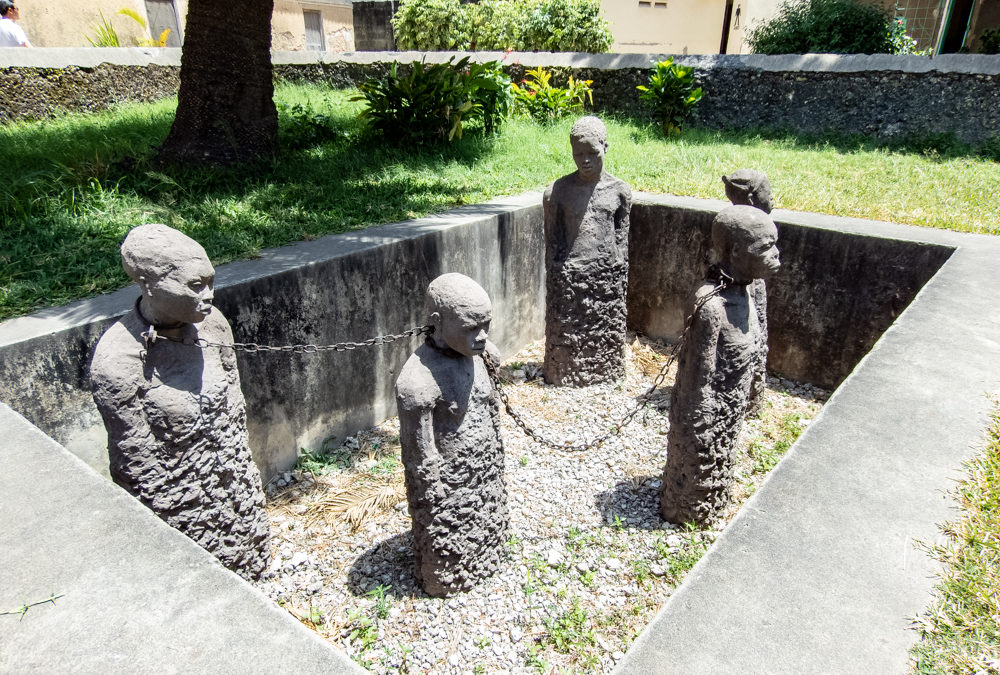One of the most beneficial aspects of travel is perspective and learning how little we know from our own backgrounds. While I didn’t intend to delve into a complete history lesson while on a recent trip to Tanzania, on multiple occasions I was presented with so much new information it has become a requirement to learn more. Call it bonus awareness from the journey.
This essay is an attempt to condense and understand a previously unknown (to the author) part of history related to the East African Slave Trade. Using on site tours, books created and purchased in situ, and online research, I have pieced together that to which we were exposed in three different locations over a two-week period: The National Museum of Tanzania in Dar es Salaam, the historic City of Bagamoyo and the island of Zanzibar. Fortunately for our educational journey, these three destinations taken in order provided a chronological context for our exposure.
The Market
Without getting into several centuries of historical explanation, it is generally understood that slavery was established long before our common understanding of 18th and 19th century importation to the United States. The earliest written indication of slave trade in East Africa is the mid-tenth century, according to which visitors from “Oman” preyed on its inhabitants and stole “their children enticing them away by offering those fruits. They carried them off to their own country.” Two centuries later in 1178 AD, a Chinese writer wrote a similar story stating that, in the west (possibly referring to Madagascar or Zanzibar)
“There is an island in the sea on which there are many savages. Their bodies are black as lacquer. They are enticed with offers of food and then captured and sold as slaves to the Arabic countries, where they fetch very high prices. Thousands of them are held as foreign slaves.”
Having driven out the Portuguese from the Indian Ocean outposts in the 17th century, Arab traders used centuries of connections with other countries to create a vast trading network. The classic seafaring routes reached as far east as China and Indonesia sharing optimal conditions in both directions.
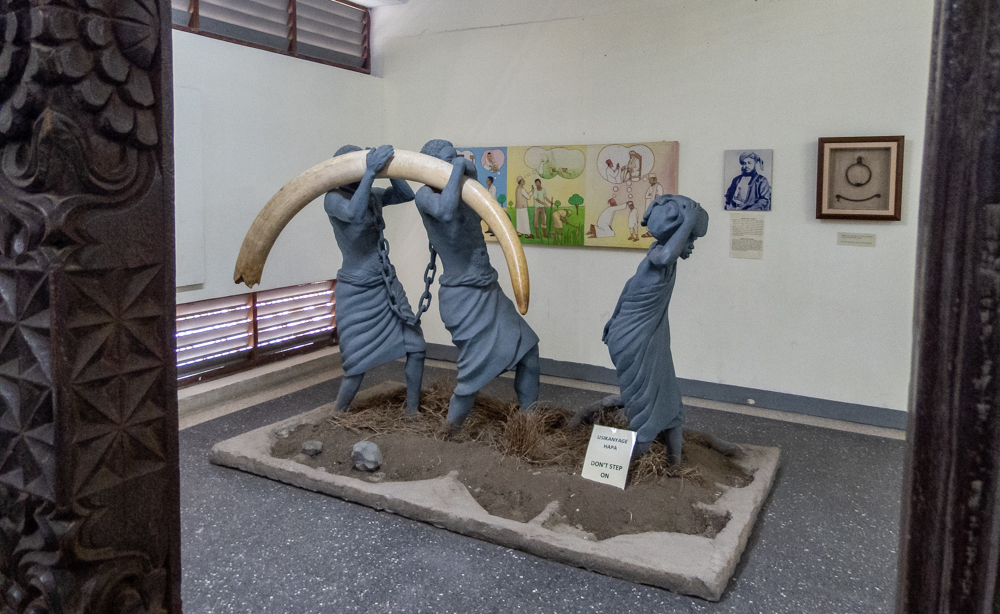
The east African slave trade reached a zenith in the 19th century primarily to support the lucrative ivory trade for the Omani Said bin Sultan (ruler of Zanzibar 1804-1856) who moved his capital from Muscat to Zanzibar and encouraged a broad range of commerce in the region. It is now estimated that nearly three million souls became victims of the slave trade in east Africa between 800 and 1899.
By the early 1800s, ivory had become the largest trade with the source far inland in east Africa. To acquire and transport this immense load required captured tribal men, women and children on a forced march carrying the heavy loads for as long as four months to reach the coastal cities.
Most slaves were procured in the region around Lake Nyasa. The journey down to the coast caused much suffering to slaves, some died of exhaustion, disease, malnourishment, and whoever attempted to escape was shot. Bigger external demands for slaves and also ivory, at higher prices than slaves, offered in the coastal ports enticed the coastal traders to vehemently search the interior.
The Zanzibar port competed with other slave trade centers on the eastern coast of Africa such as Kilwa in Tanzania mainland and Quelimane in Mozambique. From the middle part of the 19th century however, Zanzibar became the hub of all the important trade in eastern Africa, superseding all other centers and turned into a major slave trade center for the whole region of eastern Africa.
The town of Bagamoyo was an example of a caravan destination, specifically the closest to Zanzibar, carrying hides and ivory to market. Slave caravans would descend from inland into the port which developed large warehouses for the ivory and other warehouses for the slaves. For these enslaved persons, this was only the beginning of a series of tortuous stages in their journey.
Some would be sold in the coastal towns to support the households and plantations on the mainland. Most would be evaluated and loaded onto small dhows for a five-day sail to Zanzibar. Upon arrival, they would be taken to various industrialized slave warehouses for as many as 70 days. The Zanzibar slave market was renown for using a whipping post as a test of strength with most – regardless of age, gender or illness – given public lashings to determine financial value.
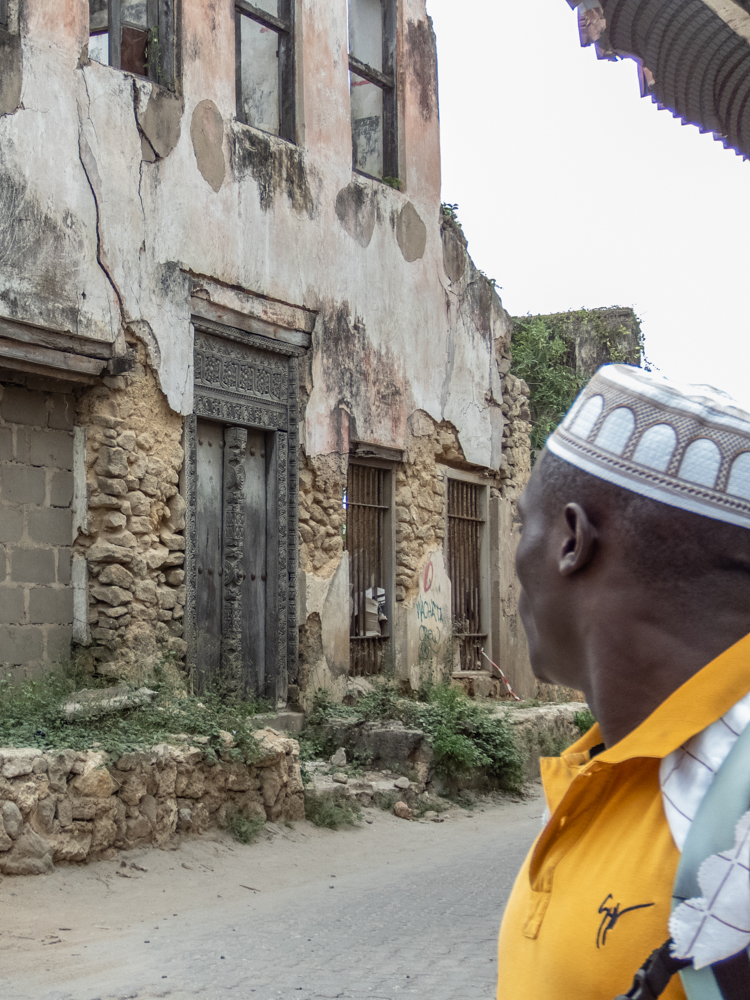
The large open slave market that developed at Mkunazini in the Zanzibar town was the greatest distribution center for slave in east Africa. The slaves were received here from various parts of eastern and central Africa, auctioned and flicked through before dealers bought them. It is estimated that a well-attached market comprised a source of slaves for most Zanzibar plantation labor. The site of the former slave market is reputed to be the last open slave market in east Africa and the world as a whole.
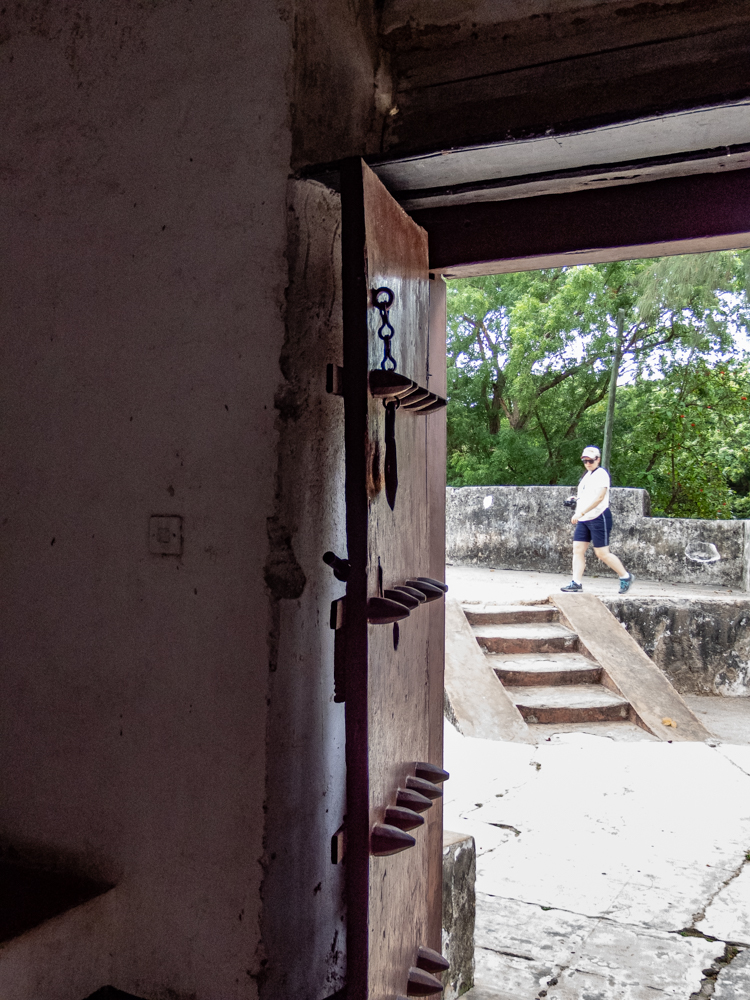
Sugar, coffee and spices were all in high demand in the greater world economy and beginning in 1820, the ruling sultans began to commercially farm vast acreage on many islands including Madagascar, Reunion and Zanzibar. Profits in spice farming increased 500% on the UK market from 1840 to 1850 providing incentive to continue finding labor to support operations ultimately using as many as 100,000 until 1870 when the spice market collapsed. Slaves sold might be as household hands in Zanzibar, to become plantation labor in the great spice plantations, or to be shipped across the seas.
Having purchased slaves in Zanzibar, Arab dealers repacked them for a long voyage to the northern ports of the Indian Ocean. During the opening years of the century, annual import to Zanzibar is estimated to be about 15,500 slaves; just over 60% of these were re-exported to Arabia, Persia, Egypt and other eastern countries in the northern ports of the Indian Ocean where there was a demand for slave labor.
Sir Bartle Frere wrote of Zanzibar: “That slave market where I saw the slaves lying in dozens and scores, some of them chained, and all of them bearing on their faces and emaciated limbs the stamp of servitude”.
The Anglican Bishop Edward Steere added, “There were the rows of men, women and children sitting and standing, the salesmen and purchasers passing in and out among them, and bandying their filthy jokes about them, and worse scenes still going on in all the huts around”
American Interests
Concurrent to Arab slave trading, trade with the US, begun as early as 1770, was becoming a principle partnership outpacing other western countries as early as the first Omani-US trade treaty ratified by the US Congress in 1833. Massachusetts-based seafarers established multiple links in the otherwise ancient Indian Ocean trade arena resulting in lucrative individual business dealings leading to the establishment of the first Consulate in East Africa being the US Consular assignment of Richard Waters (of Salem, MA) to the Sultan of Zanzibar in 1837. Mr. Waters had been sent with conflicting instructions from Washington to “not take advantage of your position there” as well as to “make the venture worthwhile” for your “unusual privileges” of position.
Waters made good use of his authorities especially as relates to easing arrangements and logistics for fellow Salem merchants exchanging information about the market for goods such as gum copal (for making varnishes), animal hides and ivory. After a rocky start, Waters used his considerable business acumen to establish insider connections creating a unique monopoly position between all foreign incoming trade (effectively shutting out the British in particular) and the customs authorities for the sultan while the customs official became equally rich on the exporting trade from the coast through Zanzibar.
But while he was a shrewd businessman, Waters was also a deeply devout Christian and the irony of being a strong abolitionist in a deeply competitive economy relying directly and indirectly on the slave trade and slave labor was not lost on him. While Waters (along with contemporary British emissaries) supported missions and missionaries of all nationalities as much as possible, it was the Sultan himself who facilitated their efforts including a generous donation of land to the Roman Catholic Church in Bagamoyo (see below). To what extent each man influenced the other in these activities, it is not known.
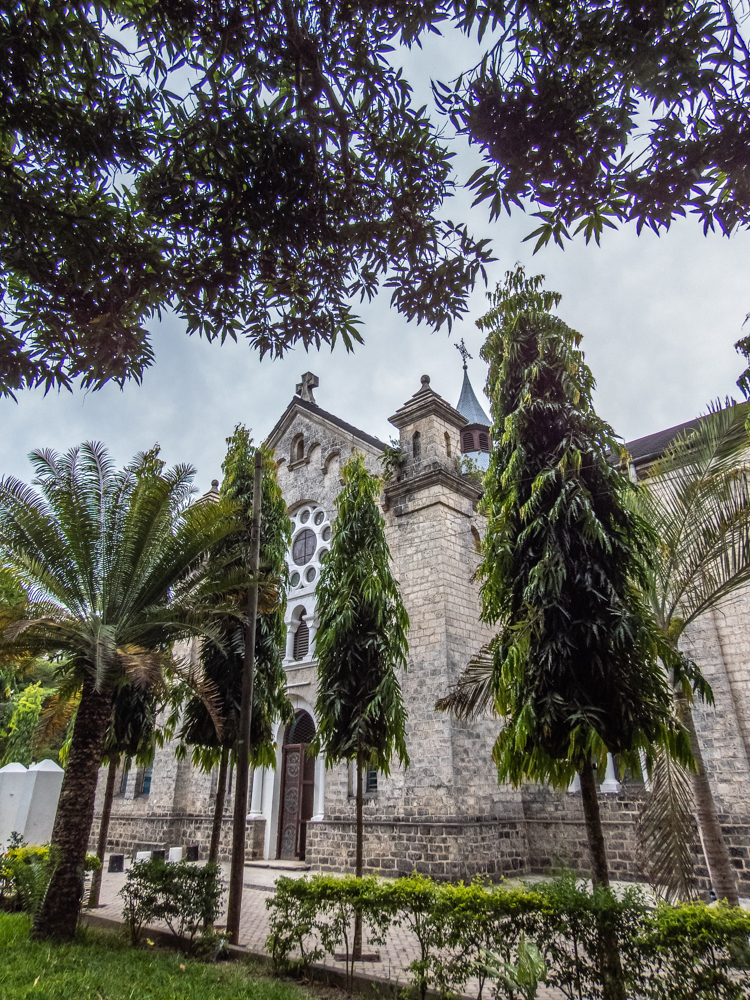
Said bin Sultan was extremely tolerant of Christian missionaries making him a most unusual leader in this respect. “All religions are not merely tolerated but protected by his highness, and there is no obstacle whatever, to prevent the Christian, the Jew, or the gentile from preaching their peculiar doctrines, or erecting temples.” Edmund Roberts stated in 1833.
One explanation for his tolerant attitude was a desire to foster contact with the outer world. Having already established relationships with the Hindus of India and the Jews of the Levant as part of a long strategy of the sultanate within the Indian Ocean trade networks, it was not a stretch to include other religions as they became trading partners in an effort to diversify the economy of both Zanzibar and Oman.
It is also possible, as voiced by Bagamoyo historians, that Sultan Majid bin Said was motivated by Muslim theology. It is known he was devout in both practice and action. One historian notes slavery was not forbidden by God, giving slaves basic rights in the Muslim society. “Your slaves are your brothers. God himself put them under you. Now you have to give them the food which you are eating and the cloths you are wearing. Do not order them a work to do which is too heavy for them and if you are doing it do yourself the work as well.”
The Koran says in Sure 2, verse 177: “Piety does not mean to face while praying to the West or to the East. It is truly pious to believe in God, in the day of the last judgement, in the angels and in what the prophet has said, but also to donate money to poor relatives, to orphans and to those in need and to ransom slaves.” Had the Sultan in mind to follow the obligations of the Koran when he donated land and went out of his way to assist mission work throughout his kingdom?
Additionally, there was an intentional political effort to ‘keep thy enemies closer’ preferring to know the inner thoughts and communications throughout the vast geographic realm, particularly on the coastal supply chain to Zanzibar, with British government-supported abolitionists, French colonialists and competing tribal traders.
Regardless of the reason, the net effect of the Sultan’s tolerance for support of missionaries gave Waters complete comfort in facilitating personal, professional and official relationships with multiple missions both in Zanzibar and inland.
In February 1837 Waters, observing two slave ships arriving, wrote, “Slavers are filled with Slaves, mostly with children, from 10 to 14 years of age. This sight called up many unpleasant feelings. What can I say to those engaged in this trade, when I remember the millions of Slaves which exist in my own country?” Clearly, he was conflicted with his official and business duties vs his religious and moral beliefs.
By 1841, the British sent a permanent Consul to Zanzibar with a clear foreign policy goal to suppress the slave trade. It took until 1845 for Consul Hamerton to construct a new treaty with the Sultan prohibiting the slave trade altogether from the African dominions while permitting the trade to continue between the mainland Arab ports in East Africa and Zanzibar.
Ultimately British strategy in relation to the whole of East Africa was two-pronged. First, was the gradual banning of the slave trade. Second, was to claim the economically indispensable Indians in Zanzibar were British subjects and control their activities accordingly. Officially the Americans were not interested in supporting the slave ban and, in some instances, American merchants successfully helped the Sultan transport slaves after the ban.
To further confuse the situation, the French returned to the trade after the French Revolution (1848) in an attempt to assist the French plantations on the island of Reunion who were desperately in need of labor.
The Missions
In 1807 the British government proclaimed slavery of people by other people as illegal and all slaves in England and their colonies were liberated in 1833. France followed in 1848. As early as 1822, Europeans came to East Africa expressly to stop slavery as soon as possible. Mission churches were established by the Vatican, British and Germans before 1870 including the Roman Catholic Spiritans mission in Bagamoyo.
Founded by Fr. Anton Horner in 1868, the Christian Freedom and Protective Village of Bagamoyo for former slaves became the focal point for mainland missions and began ransoming slaves and resettling them in north Bagamoyo, carrying on the efforts began by the Roman Catholic order initially on the islands of St. Denis/Reunion and, in 1860, on the neighboring island of Zanzibar.
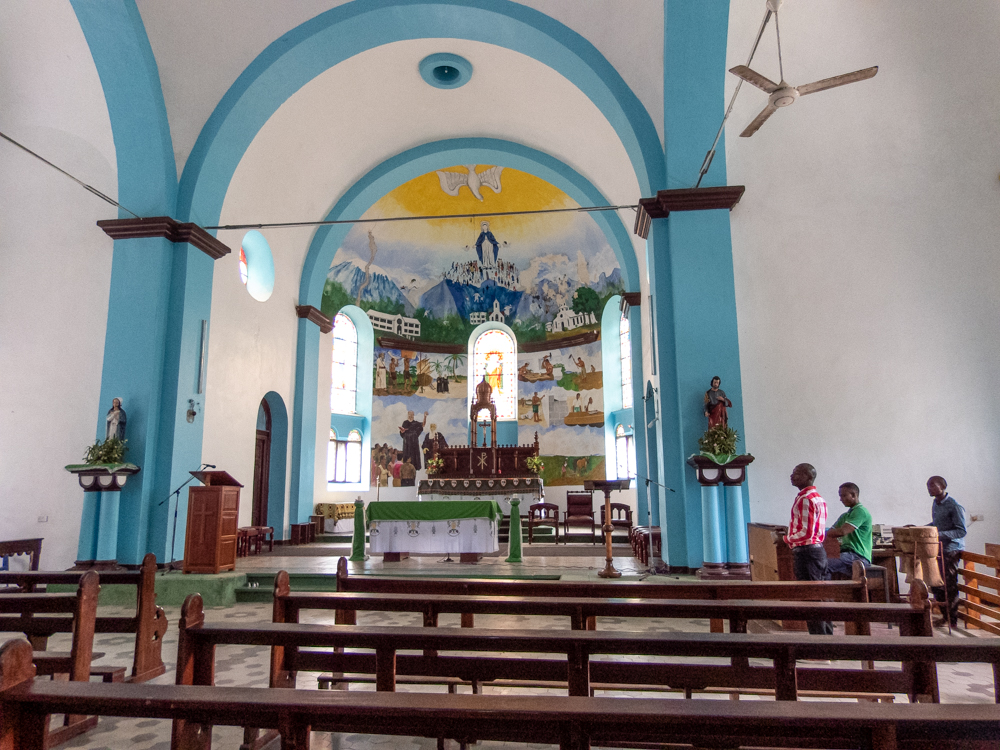
In 1867 he wrote, “I thought about the foundation of a colony in Bagamoyo, which lies on the East African coast. The ground is fertile and that will support the mission. Our married Christians will establish their own households. The first settlement will evolve; also because of joining with other Negroes. Missionaries will establish new missions with Christian couples. In these new places the couples will form the first Christian communities with their children and attract other African people. Because of the continuing raids of some tribes there is no doubt that a wide range of troubled indigenous people will come to our villages to find peace and happiness.”
Fr. Horner experienced the Arabic slave traders in Zanzibar and also in Bagamoyo and reported on it in his letter to Europe about the slave market in Zanzibar on July 8,1863: “Twice a day the poor slaves are sold to the highest bidder, like we do it in Europe with animals. The bidder examines the slave he wants to buy. He opens his mouth, checks his teeth and checks all muscles. After that the slave must run a distance. How could I see this degrading scene without being disgusted?” “One can see that the Arab shows no mercy with the unfortunates. A slave is like an animal to him, which is only there to work. He keeps him as long as the slave can work. But by the time he can only eat, he disposes of him as he likes.” Often Fr. Horner was known to purchase old, sick or weak slaves and take them to the Christian Freedom Village.

As mentioned above, Sultan Majid bin Said supported missionary work with gifts of land, letters of introduction to inland tribal leaders and general logistical and security support.
In 1873, the British Consul, Sir Bartle Frere, forced Sultan Seyyid Bargash bid Said, Majid Bin Said’s successor, to close the Zanzibar slave markets effectively shutting down major slave trade in the entire region and tearing down the Zanzibar slave market placing the Anglican Church with its altar directly on the whipping post location.
The Anti-Slavery Conference of Brussels attempted to ban all slave trade in 1889 but some trade continued particularly between warring mainland tribes. The conference introduced basic rights for slaves, which slave owners had to obey:
The right to practice religion freely; The right to marry; The right to free food and free housing; The right to have two days a week without any work; The right to be paid for work done; The right to have own possessions; The right to gain a share of the owner’s heritage; The right that families cannot be separated by sale.
Additionally, Germany and Belgium determined four ways to liberate a slave from slavery in the colony “German East Africa” as
By purchase; By being released by the owner; By decision of Court; By self-purchase.
Documents of manumission were created to include the name of the slave, information on place of birth or origin, current residence, age, gender, name of slave owner and the work they did. Copies of official manumission documents were maintained by German colonial district offices and remain a strong source of information.
The decree of December 31, 1905 determined that children of slaves born after January 1, 1906 would be permanently free within the German East African colonies. Letters of manumission continued to be dated as late as 1915 showing plantation labor as the primary source of slavery along the mainland coast.
Statistics from Bagamoyo alone indicate the following total number of liberated slaves as:
From 1870-1879: 1513 slaves
From 1880-1889: 758 slaves plus 70 families in 1880
From 1890-1899: 1158 slaves
From 1900-1920: 203 slaves
For a total of 3616 slaves plus 70 families. Estimates indicate 234,000 slaves on the mainland for the period so 3616 appears to be a very low percentage. Many, not all, of the freed slaves were baptized with official church documents containing various details including age, status, gender and some notes.
A few examples:
April 20, 1870 Maria Anna Pascha, 5 months, “lost her parents due to slavery and was then freed by us”
Barbara granted an emergency baptism on June 3, 1876 at the age of 90 years. (Emergency baptisms were often offered to those close to death.)
Constantius Deusdedit, baptized April 2, 1877 was “purchased free by Fredericus and Julius, baptized on Dec 5, 1877, by his godfather of same name Julius”.
1884, entry 9: Henricus freed on January 31, 1884 by Fr. Meves. “His mother, a slave, was publicly burned as a witch. Her son, seven years old, was to suffer same destiny but Fr. Meves could buy him for 3 rupees and took him to the Christian Freedom Village for protection.”
1884, entry 24: Maria Magdalena from Nzole near Bagamoyo “belongs to the Wadoe tribe and came to us at the age of 50. Due to her weakness, we offered her baptism. She agreed, but firstly asked for a tobacco pipe and got baptized after having smoked it. She died a few days later.” (The missionaries understood the Wadoe tribe to smoke or take a pinch of snuff before important ceremonies took place and honored her request.)
1885, entry 49: Dionysia Mlauselle, from the tribe of Wemba, was caught as a slave during her childhood. “She came to us with her son, who was also a slave.” Dionysia was baptized on August 3, 1885 at the age of 19. She married on March 12, 1886 and moved with her husband to the new missionary station Mhonda where she helped establish a Christian parish.
1885, entry 108: David Titoreke, also from the tribe of Wazaramo, was 6 years old when he was baptized on 17th February 1885. He died on August 31, 1888; probably “due to syphilis or leprosy.”
1885, entry 113: Alexina Kitunga, also of the tribe of Wazaramo, was bought and freed on March 29, 1884 and baptized on July 12, 1885. “Because she had burns all over her body, we could purchase her for a little money. She was full of fear because her owner had told her that the white men intended to eat her. She showed her body and said: ‘My flesh is burned and therefore not tasty.’ “
1886, entry 224: Bartholomaus Kocheni was baptized on January 6, 1886. He knew that he had been stolen but did not know by whom.
Similar entries abound revealing more about the slavery in the region and conditions to which all ages and abilities were taken in by the Bagamoyo Spiritan mission. Other missions have equally compelling documentation as a matter of routine to keep track of their efforts and the souls saved in the name of their religions.
Despite continued efforts by missionaries and governments, slavery was not completely abolished on the East African mainland until 1920.
Other missionaries included Dr. David Livingstone who worked in Africa from 1840-1873. His loyal African companions brought his dead body to the Spiritan missionaries in Bagamoyo on Feb 24, 1874. “It was a day when a group of Africans arrived in great grief. They entered our ground silent and put a body in front of the church door. When one of the Fathers arrived, the leader of the group said: ‘The body of Daudi – the corpse of Dr. Livingstone’ We sent a dhow to Zanzibar immediately for reporting the message to the British consul. The coffin was made in our carpenter’s shop and a few hours later the body of Dr. David Livingstone was at rest in our church. Hundreds of former slaves, men, women and children honoured him with a nightly vigil.” On February 25th, a dhow brought the coffin to Zanzibar and on April 18th Dr. David Livingstone was buried in Westminster Abbey in London.
Livingstone had begun his missionary work on behalf of the London Missionary Society in South Africa and been encouraged to move north to end human trafficking. His first journey to East Africa was in 1852 and, unlike other European explorers of the time, was without fanfare or large caravan preferring to be accompanied by only a few men. Already on his first journey, he saw cotton fields and knowing the demand for cotton from his textile work near Glasgow as a young man a vision grew in him: “To open the spirit of the Africans for Christianity a trade with them need to begin. The prospects are better than expected. I hope the production of raw material for our factories will link the African and English interests and I hope both sides benefit from this. Anti-slavery agitation will also benefit from this.”
Thus, Livingstone developed his ‘3-C-Concept’: “Commerce, Christianity, Civilisation”. As a prolific reporter back to the developed world, Livingstone inspired many missions and actions to abolish slavery. In Zanzibar, he described the central slave market in 1866 as “I found nearly 300 slaves on this market being put up for auction like cattle. The bidders examine the teeth and lift their clothes to see their legs, then they throw a stick away so that the slave can bring it back thereby showing his way of walking. The bidders also palpitate the muscles of the slaves. Female slaves were brought to a cabin to be examined there.”
These observations fortified the abolishment of slavery as he intended. “If my reports can contribute to abolishing this horrible slave trade then this will mean much more to me than having found the springs of the Nile.” Dr. Livingstone died on May 1, 1873 some distance from the coast. The doctor, Matthew Wellington, took out his heart and intestines and buried them at the spot where he died. The body was mummified and loyal servants carried it to Bagamoyo and the coast.
To the present day, the old tower of the first church on the grounds of the Catholic Parish in Bagamoyo is called “Livingstone Tower.” The interior reminds of “all missionaries who did all one can do for the welfare of all East Africans.” Both Fr. Anton Horner and Dr. David Livingstone are remembered on site.
In 2009, the Catholic Parish of Bagamoyo interviewed descendants of slaves and descendants of slave owners to document family stories and lore. Ranging in age from 42-109, some had first-person memories and others recalled stories of parents and grandparents. All are available for review, but the effort shows the continued presence of the Spiritan mission to guide and heal more than a century later. Additionally, the Mission is dedicated to continued efforts to abolish human trafficking of all forms throughout East Africa as are many other missions in the region.

The Anglican Church of Zanzibar, established on the site of the central slave market, also continues a strong mission to educate and provide a clearer understanding of the events and activities from multiple perspectives. Their museum is a member of the International Coalition of Sites of Conscience and has, since 2010, had a permanent exhibit in addition to resources online for additional study.
As often happens, learning while traveling provides a need for additional education. Clearly, for me this exposure has been a reminder how selective our history is taught and the vastness of the unknown. These facts learnt on our trip will serve only as a beginning to answer more questions. Where did the ones who were sold in Zanzibar go? Were they imported to the US? Can we track the implications of this Indian Ocean trade to our shores? Surely, we have seen Salem, Massachusetts as an early trading location directly with the Sultanate. Cannot other American-based interests have been close behind?
With trade agreements a solid thirty years before our own Civil War, would it not be highly likely we traded in not only cotton and gum for varnishes but also humans?
I’m intent on learning more and filling some gaps. Dr. Livingstone’s diaries and biography are available. So is a recommendation of the general situation in East Africa to read both The Blue Nile and The White Nile. And a visit to the African American Museum in DC with a specific intent to learn more about East African trade is already scheduled.
Where will this lead? Just to self-knowledge? Perhaps to expand thoughts on current conditions both locally and nationally? As one author from Bagamoyo put it, “The relatives of former slaves and former slave owners live together in the same place. The descendants of former slaves know the descendants of the ones that owned their parents or grandparents. These are only three generations. Differences start to alleviate now.”
Perhaps with knowledge, the path to mutual understanding will improve.
References
Details from the Tanzania National Museum, Dar Es Salaam, touring Bagamoyo and the Catholic Parish of Bagamoyo with the Christian Freedom Village, the Christ Church Cathedral of Stone Town.
http://www.bagamoyo.org/Mantep.htm The Catholic Parish of Bagamoyo
http://www.formerslavemarketsitezanzibar.com/ The Anglican Cathedral of Zanzibar
Zanzibar: An essential guide by Amanda Harley
19th Century Humans as Merchandise, Slaves in Bagamoyo by Fr. Johannes Henschel
Bagamoyo: The Spirit of the World by Rev. Peter R. Junior

